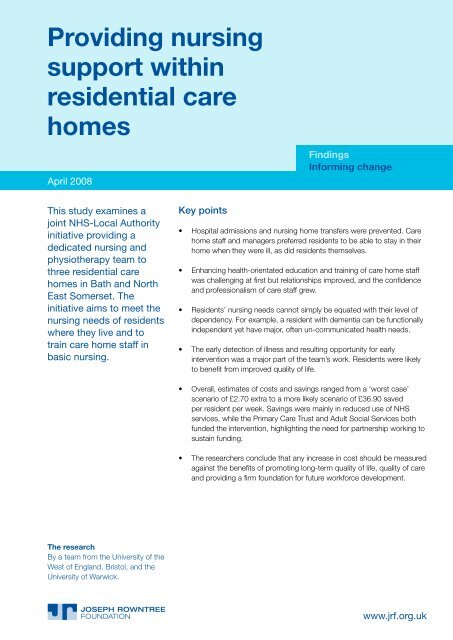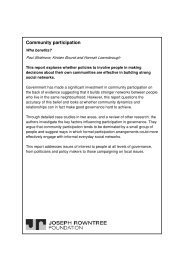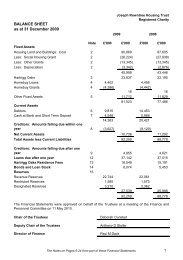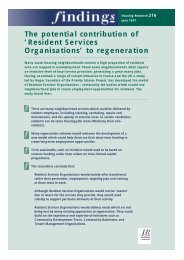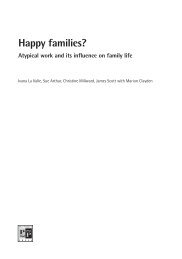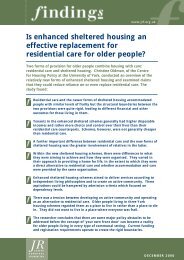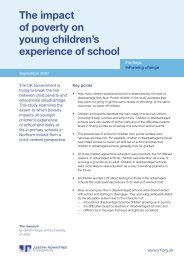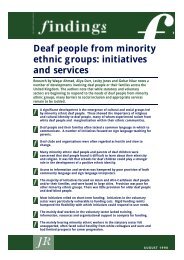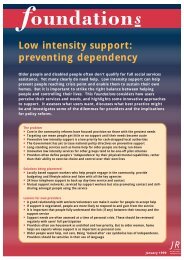Providing nursing support within residential care homes - Joseph ...
Providing nursing support within residential care homes - Joseph ...
Providing nursing support within residential care homes - Joseph ...
Create successful ePaper yourself
Turn your PDF publications into a flip-book with our unique Google optimized e-Paper software.
<strong>Providing</strong> <strong>nursing</strong><br />
<strong>support</strong> <strong>within</strong><br />
<strong>residential</strong> <strong>care</strong><br />
<strong>homes</strong><br />
April 2008<br />
Findings<br />
Informing change<br />
This study examines a<br />
joint NHS-Local Authority<br />
initiative providing a<br />
dedicated <strong>nursing</strong> and<br />
physiotherapy team to<br />
three <strong>residential</strong> <strong>care</strong><br />
<strong>homes</strong> in Bath and North<br />
East Somerset. The<br />
initiative aims to meet the<br />
<strong>nursing</strong> needs of residents<br />
where they live and to<br />
train <strong>care</strong> home staff in<br />
basic <strong>nursing</strong>.<br />
Key points<br />
• Hospital admissions and <strong>nursing</strong> home transfers were prevented. Care<br />
home staff and managers preferred residents to be able to stay in their<br />
home when they were ill, as did residents themselves.<br />
• Enhancing health-orientated education and training of <strong>care</strong> home staff<br />
was challenging at first but relationships improved, and the confidence<br />
and professionalism of <strong>care</strong> staff grew.<br />
• Residents’ <strong>nursing</strong> needs cannot simply be equated with their level of<br />
dependency. For example, a resident with dementia can be functionally<br />
independent yet have major, often un-communicated health needs.<br />
• The early detection of illness and resulting opportunity for early<br />
intervention was a major part of the team’s work. Residents were likely<br />
to benefit from improved quality of life.<br />
• Overall, estimates of costs and savings ranged from a ‘worst case’<br />
scenario of £2.70 extra to a more likely scenario of £36.90 saved<br />
per resident per week. Savings were mainly in reduced use of NHS<br />
services, while the Primary Care Trust and Adult Social Services both<br />
funded the intervention, highlighting the need for partnership working to<br />
sustain funding.<br />
• The researchers conclude that any increase in cost should be measured<br />
against the benefits of promoting long-term quality of life, quality of <strong>care</strong><br />
and providing a firm foundation for future workforce development.<br />
The research<br />
By a team from the University of the<br />
West of England, Bristol, and the<br />
University of Warwick.<br />
www.jrf.org.uk
Background<br />
Over the last 20 years, changes in health<br />
<strong>care</strong> provision have resulted in increased<br />
reliance on community services, focusing<br />
the NHS role towards one of acute <strong>care</strong><br />
provision. Estimates suggest that there<br />
are now some 440,000 places in the<br />
registered <strong>care</strong> home sector, most of<br />
them for older people.<br />
The National Service Framework for Older People<br />
(Department of Health, 2001) formed the basis of<br />
successive policy for the reconfiguration of services<br />
in the <strong>care</strong> sector as a whole. Policy has indicated<br />
particular interest in the provision of intermediate <strong>care</strong><br />
and the promotion of partnership working, including<br />
multi-agency assessment.<br />
Within the <strong>care</strong> home sector in particular, it<br />
is recognised that there are differences in the<br />
management of <strong>homes</strong> and access to NHS <strong>nursing</strong><br />
and other expertise. The involvement of <strong>care</strong> <strong>homes</strong> in<br />
rehabilitation is also acknowledged to be variable. The<br />
training and education of <strong>care</strong> home staff is seen as<br />
crucial in addressing the complexity and dependency of<br />
older residents’ needs and ensuring a good quality<br />
of <strong>care</strong>.<br />
This study reports on an evaluation of an initiative in<br />
Bath and North East Somerset (B&NES) involving the<br />
Local Authority and the Primary Care Trust. In this area,<br />
a dedicated team provided <strong>nursing</strong> and physiotherapy<br />
to <strong>support</strong> up to 131 residents in three local authority<br />
<strong>residential</strong> <strong>care</strong> <strong>homes</strong>. The team members also<br />
<strong>support</strong>ed enhanced health and <strong>nursing</strong> training for<br />
designated <strong>care</strong> staff <strong>within</strong> the <strong>homes</strong>.<br />
Prevention of hospital admissions and<br />
<strong>nursing</strong> home transfers<br />
Evidence from interviews and focus groups suggested<br />
that enabling residents to stay in their home when they<br />
were ill was preferred by <strong>care</strong> staff, managers, and most<br />
importantly by residents, who gained a greater sense of<br />
security from continuity of <strong>care</strong> in a familiar environment.<br />
Audit data suggested that the <strong>nursing</strong> and<br />
physiotherapy expertise from the <strong>nursing</strong> team,<br />
combined with their <strong>support</strong> for the development of<br />
new types of working amongst designated <strong>care</strong> home<br />
staff, was able to avert between 81 and 197 potential<br />
hospital admissions over the first two years (between<br />
July 2005 and June 2007). In addition, 20 early<br />
discharges were facilitated.<br />
Over the same period, a comparison of hospital data<br />
from the <strong>homes</strong> involved in the pilot scheme shows a<br />
decrease in admissions for more than 48 hours and an<br />
increase in those of less than 48 hours. This suggests<br />
the model has had a positive impact in preventing<br />
longer admissions and facilitating early discharge.<br />
However, the time span of two years was too short<br />
to demonstrate a meaningful trend in either type of<br />
hospital stay.<br />
Audit data also suggested that the <strong>nursing</strong> team’s work<br />
prevented 20 (or possibly up to 28) residents from being<br />
transferred to a <strong>nursing</strong> home.<br />
Savings to the local authority and Primary Care Trust will<br />
vary depending on whether this represents a delaying<br />
mechanism for transfers to <strong>nursing</strong> <strong>homes</strong> or a longerterm<br />
measure for preventing them. Again, the time span<br />
was too short to demonstrate the long-term effect.
Resident dependency<br />
Results of assessments carried out using the Minimum<br />
Data Set (MDS) <strong>care</strong> assessment tool indicated <strong>nursing</strong><br />
needs in a majority of residents, whereas <strong>care</strong> staff’s<br />
routine assessment scores, based on residents’<br />
ability to carry out Activities of Daily Living, indicated<br />
dependency needs in only a minority of residents drawn<br />
from the same population. As the two scores measure<br />
different things, this should not be viewed as conflicting<br />
evidence. For example, a resident with dementia can<br />
be functionally independent yet have major, often<br />
un-communicated health/<strong>nursing</strong> needs.<br />
However, the findings do suggest it is important for<br />
residents to receive a more comprehensive routine<br />
health assessment than one which is focused on<br />
functional ‘activities of daily living’, as a precursor<br />
for better <strong>care</strong> planning and intervention. This has<br />
implications both for the knowledge level required by<br />
<strong>care</strong> home staff taking on ‘new types of working’ roles<br />
and for the level of <strong>support</strong> they may require from a<br />
nurse.<br />
Detection of illness<br />
The early detection of illness and resulting opportunity<br />
for early intervention was a major part of the <strong>nursing</strong><br />
team’s work, accounting for a high number of visits to<br />
residents to deal with conditions uncovered. Although<br />
it is possible to estimate the impact of this in terms of<br />
cost (per visit), it is not possible to determine savings.<br />
Indeed it could be that uncovering often complex health<br />
needs will increase initial costs but create long-term<br />
savings in preventing the deterioration of people’s<br />
health. However, there are likely to be benefits to<br />
residents in terms of improved quality of life, in particular<br />
for individuals who have problems communicating their<br />
illness and its symptoms.<br />
Contribution to teaching and learning<br />
Another important area of work for the <strong>nursing</strong> team<br />
was to enhance the ‘new types of working’ amongst<br />
designated <strong>care</strong> home staff, <strong>support</strong>ing them in<br />
their move towards new health-promoting roles and<br />
responsibilities. There were early challenges with this<br />
in the first year of the project, when each group was<br />
perceived by the other as being ‘too set’ <strong>within</strong> their<br />
particular discipline (<strong>nursing</strong> or social <strong>care</strong>). However,<br />
understanding and mutual respect had improved by the<br />
second-year staff interviews and <strong>care</strong> staff were more<br />
confident in performing new roles. These improvements<br />
are backed up by related audit and quality assurance<br />
data which shows the amount of time given by the<br />
<strong>nursing</strong> team to teaching and clinical supervision in both<br />
a formal environment and informally in the <strong>homes</strong>. By<br />
the last phase of the study, evidence suggested that<br />
the team had adopted a case management or personcentred<br />
approach (as opposed to the task-orientated<br />
approach observed earlier in the study). This was more<br />
beneficial to building relationships with those in new<br />
roles and in the establishment of the home as a learning<br />
environment.<br />
Costs and savings<br />
Estimates of costs and savings suggested that the cost<br />
of the pilot (£43.94 per resident per week) might in the<br />
‘worst case’ scenario exceed the estimated savings<br />
made in the same period by £2.70 per resident per<br />
week. However, in the more likely scenario, the pilot<br />
may have actually produced an overall saving equivalent<br />
to £36.90 per resident per week, or nearly £250,000<br />
per annum.<br />
The principal savings related to avoided hospital<br />
admissions, closely followed by avoided transfers to<br />
<strong>nursing</strong> <strong>homes</strong>. Savings due to early discharges from<br />
hospital were lower but appeared to offer the potential<br />
for increase. The benefit of early detection of illness was<br />
difficult to quantify in monetary terms, but may add to<br />
savings in the longer term.
Some data was collected at a time when early<br />
challenges of implementation were still apparent. This<br />
may well have inhibited some cost-saving activities<br />
and led to a sizeable underestimation of the model’s<br />
true potential over a longer period of time. Similarly, the<br />
cost of the pilot service might have been overestimated<br />
because the original set-up offered potential for<br />
refinement without major loss in effectiveness.<br />
With these points in mind, the researchers conclude<br />
that the key remaining question is whether any final<br />
increased cost associated with the pilot (if indeed any<br />
exists) is worthwhile in terms of the following additional<br />
benefits:<br />
• promoting long-term quality of life and quality of<br />
<strong>care</strong> of residents;<br />
• providing a firm foundation for ‘new role’ workforce<br />
development.<br />
About the study<br />
The research was carried out by Deidre Wild and Sara<br />
Nelson of the Faculty of Health and Life Sciences,<br />
University of the West of England, Bristol, with Ala<br />
Szczepura, of Warwick Medical School, University of<br />
Warwick.<br />
The overall research design brought together multiple<br />
sources of evidence. Focus groups and interviews<br />
were conducted with key stakeholders, <strong>nursing</strong> team<br />
members, <strong>care</strong> home managers, <strong>care</strong> staff, and<br />
resident groups. An economic evaluation was included<br />
to estimate the cost of the model and the cost savings<br />
it achieved.<br />
For further information<br />
This summary brings together the findings from two interim reports from the evaluation:<br />
The In Reach Model Described from the Perspectives of Stakeholders, Home Managers, Care Staff, and<br />
the In Reach Team (May 2007), available from: deidre.wild@uwe.ac.uk.<br />
and<br />
Audit of In-Reach Team (IRT): Activity, Costs, Benefits & Impacts on Long-Term Care (September 2007),<br />
available from: ala.szczepura@warwick.ac.uk<br />
For further information please contact Deidre Wild on 01452 702166 or Ala Szczepura 024 7652 3985<br />
Published by the <strong>Joseph</strong> Rowntree Foundation, The Homestead,<br />
40 Water End, York YO30 6WP. This project is part of the JRF’s research<br />
and development programme. These findings, however, are those of the<br />
authors and not necessarily those of the Foundation. ISSN 0958-3084<br />
Read more Findings at www.jrf.org.uk<br />
Other formats available.<br />
Tel: 01904 615905 email: info @jrf.org.uk<br />
Ref: 2202<br />
www.jrf.org.uk


